|
Vintage
engine collectors and historians will love this article from the
1963 Annual edition of American Modeler. It is chock full of information,
line drawings, and photographs of what was probably fairly comprehensive
coverage of all the engines being produced at the time. The list
is not restricted to the USA; it also includes engines from Italy,
France, the USSR, West Germany, and others. Extensive tables are
provided detailing specifications for both glow fuel and diesel
fuel. Be sure to click on the images to see larger versions. Enjoy.
Global Engine Review
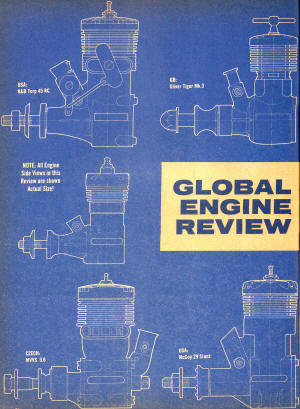 Never
before has there been so comprehensive a round-up of he world's
air-model powerplants as offered here. If you find this compendium
of special help, the editors would appreciate hearing from you and
your model club. Never
before has there been so comprehensive a round-up of he world's
air-model powerplants as offered here. If you find this compendium
of special help, the editors would appreciate hearing from you and
your model club.This roundup is designed to list every model
airplane engine currently available in the world today - at least,
in their respective countries - and to comment on those of particular
interest. Featured are more than 270 types. Practically every basic
design is listed and, in some cases, different versions. Sometimes,
a manufacturer may offer as many as six variations of a standard
model, but with only very minor differ-ences. The German Jena .15
c.i.d. "diesel," for example, is not only made in disc-valve and
reed-valve versions, each type is available with large or small
diameter cylinder fins. Since these latter differences do not affect
the general specifications of the engine only the basic designs
are listed to avoid excessive duplication of date. The hobby-model
market develops and changes so rapidly the question naturally arises:
how up to date is our listing? First we should say a word about
how most engine manufacturers work. Some produce engines continuously
(particularly popular .049's), but generally engines are built in
batches - i.e., a maker may run off ten thousand .35's and then
turn his attention to .15's and .19's for a while. Later he goes
back to his .35 or to some other size. Particularly with special
types, like racing .29's and .60's, a manufacturer might not return
them to production for a year or more ... depending on how he makes
use of his plant facilities and/or the demand for them.
Therefore, many an engine not presently in production may be considered
to be current provided that parts and finished mills are still warehoused
or there is an indication that the manufacturer may resume production.
Our list includes a few new motors which were still not obtainable
at press time, but which the manufacturers say will be on the market
in early 1963. Not all 1963's-to-be-sure are listed, since some
manufacturers were unable or unwilling to provide data on their
new babies. On the other hand, some engines still on sale are not
carried in our list because the makers advised us that no more of
that type are to be built.
 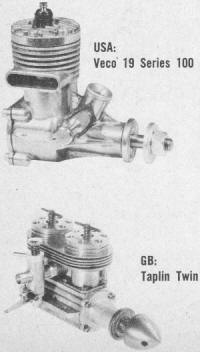 Only
engines which have been put into "series production" are included
in this survey. This qualification is simple enough to apply to
engines of the major producing nations. It is more difficult to
define in the case of Czechoslovakia and Poland and the situation
is decidedly obscure in Russia ... it is almost impossible to obtain
detailed information on model motor production from that country.
We have, therefore, included only the types definitely known to
have been turned out in series in these countries, although it should
be understood that series production in these instances can mean
anything from a few dozen to a few thousand. Large scale production
of engines is confined to the United States and, to a lesser extent,
to Britain, Japan, Germany and Italy - roughly in that order. Only
engines which have been put into "series production" are included
in this survey. This qualification is simple enough to apply to
engines of the major producing nations. It is more difficult to
define in the case of Czechoslovakia and Poland and the situation
is decidedly obscure in Russia ... it is almost impossible to obtain
detailed information on model motor production from that country.
We have, therefore, included only the types definitely known to
have been turned out in series in these countries, although it should
be understood that series production in these instances can mean
anything from a few dozen to a few thousand. Large scale production
of engines is confined to the United States and, to a lesser extent,
to Britain, Japan, Germany and Italy - roughly in that order.
Our tables show glow and diesel engines arranged in order
of displacement for easy reference. Bore and stroke data are those
given by the manufacturer or if not supplied, then obtained, wherever
possible, from measurement of actual motors. In the case of engines
of other than American or British make, these figures
U.S.A. - America pioneered the production of model
gas engines in the thirties with such spark-ignition motors as the
Brown Junior and Baby Cyclone running on gasoline. From 1947-48
on the United States developed the glowplug motor and set a standard
for the rest of the world. The oldest name in the model engine business
is that of the Herkimer (N.Y.) Tool & Model Works Inc., who
have been making their O.K. engines for more than a quarter-century.
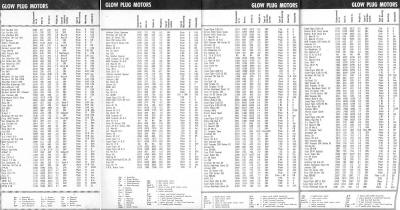
Glow Plug Motors Specification Chart

Diesel Motors Specification Chart
Smallest of the O.K. Cub range is the little .024 weighing but nine-tenths
of an ounce. It is supplied with a 5" nylon prop which it will turn
at over 13,000-rpm. Similar in design is the larger Cub .049A. Both
these motors feature a rear reed-valve intake, glow filament built
in the head and radial mounting via an integral nylon tank. The
.049B, on the other hand, has front rotary-valve induction, detachable
tank and combined beam and radial mounting. This model is also available,
unassembled, for a dollar less. Together with the .074 and .099
models, the 049B is also offered in an "S" version equipped with
self-rewind pull-cord clutch type starter. The lightest
engines in their classes are the Cub .14 and .19. Following basic
Cub layout with screw-in radially ported cylinders are the .29 and
.35 models, the largest American engines to feature this type of
cylinder design. O.K. makes two diesels, the only American made
compression-ignition engines on the market, of .049 and .075 cubic
inch displacement. Their variable compression head differs from
most European diesels in having a flange on the contra-piston which
automatically prevents the compression adjustment from exceeding
a certain value and makes the use of a nitrated diesel fuel virtually
essential. They also feature a unique "shock absorber" member between
the contra-piston and compression screw. Smallest internal
combustion engine in regular production anywhere is Leroy Cox's
Tee-Dee .010, displacing just under 1/100-cu-in, weighing a bare
half-ounce without its radial mount tank. This wonderful little
motor delivers its maximum power out-put at 27 to 28 thousand rpm,
the highest peaking speed of any production of any size to date.
It turns its standard 3" diameter prop at this speed; on reduced
load, it will quite happily exceed 32,000 rpm. Also in the
"Tee-Dee" line are the .020, .049, .051 and .09 c.i.d. models. These
shaft rotary valve engines develop very high performance in their
respective displacement groups. Cox's various .049 c.i.d. engines
have always been in the forefront of Half-A class competition, beginning
with the famous reed-valve Space-Bug and Thermal Hopper series of
ten years back... the Tee-Dee .049 currently upholds these Cox traditions.
This and the .051 (identical except for a 4 thousandths greater
bore) will exceed .14 brake horsepower at around 21,000-rpm. The
latest .09 addition is slightly smaller than other .09's to qualify
for the European 1.5cc group. Still more interesting is the fact
that it substantially exceeds the performance of the best foreign
engines of this size.
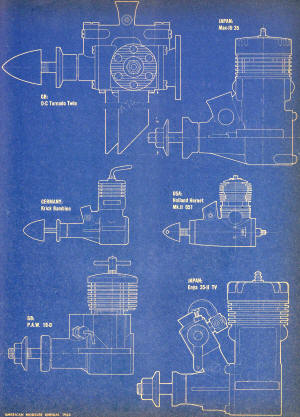 The
Cox Special .15, an improved version of the Tee-Dee .15 introduced
in 1961, was used by Swiss modeler Fritz Schneeburger to win the
last F AI World Free-Flight Championship. The high power output
of the Tee-Dee 15 (over .45-bhp at 17 to 18,000-rpm on 30% nitro
fuel) led many control line enthusiasts to try it for speed work
... where the engine was run at rpms exceeding 22,000, piston and
cylinder failure were occasionally reported. Cox therefore replaced
the Tee-Dee .15 with his new Special .15 which has an extra heavy
cylinder and wrist-pin equipped piston. Due to their high torque,
these engines develop tremendous power for free-flight work and
are likely to be numerous at the 1963 World F/F Championships. The
Cox Special .15, an improved version of the Tee-Dee .15 introduced
in 1961, was used by Swiss modeler Fritz Schneeburger to win the
last F AI World Free-Flight Championship. The high power output
of the Tee-Dee 15 (over .45-bhp at 17 to 18,000-rpm on 30% nitro
fuel) led many control line enthusiasts to try it for speed work
... where the engine was run at rpms exceeding 22,000, piston and
cylinder failure were occasionally reported. Cox therefore replaced
the Tee-Dee .15 with his new Special .15 which has an extra heavy
cylinder and wrist-pin equipped piston. Due to their high torque,
these engines develop tremendous power for free-flight work and
are likely to be numerous at the 1963 World F/F Championships.
For those who do not require top contest standards
of performance, Cox offers simplified and less expensive versions
of these front rotary models in the .049, .09 and .15 c.i.d. groups,
known as the "Medallion" line. For the Sunday sport and "fun" flyer,
there are the well established reed-valve Pee-Wee .020, Baby Bee
and Golden Bee .049, also the Sportsman 15. All these are also found
in the Cox ready-to-fly plastic models along with the rear rotary
drum-valve RR-1 .049. All Cox engines are produced by highly advanced
precision processes; crankcases are machined from solid stock instead
of being made from castings. One of the most prolific
American manufacturers is Duke Fox. Duke currently has 15 different
models on his production list. His most famous engine is unquestionably
the Stunt .35 which is known the world over. During the past ten
years it has probably powered more place-winners in C/L stunt contests
than all other makes together. In speed circles the Fox .29X has
been remarkably successful. A Fox trademark, beginning with the
original rear disc valve Fox .59 of 1947, has been his Desaxe cylinder
- i.e., the cylinder axis is offset relative to the crankshaft axis.
This feature is still found in the larger Fox engines.
 Apart
from the Stunt .35, a new Fox series began with the introduction
of the original black head Fox Combat .35 which was based on a new
crankcase design. From this, stemmed the Rocket .35, the Combat
Special and, with lengthened stroke, the .397 c.i.d. Rat-Racing
.40. Latest Fox trend in engines of this size is towards needle-bearings
or ball-bearings in place of the normal bushing. The very powerful
needle-bearing Combat Special (around .9-bhp on test) was the first
of these, followed by the remarkably low-priced .35X to replace
the Rocket .35). Due in the hobby shops is a new .40 with the crank
journal supported via a rear ball· bearing and a front needle-bearing. Apart
from the Stunt .35, a new Fox series began with the introduction
of the original black head Fox Combat .35 which was based on a new
crankcase design. From this, stemmed the Rocket .35, the Combat
Special and, with lengthened stroke, the .397 c.i.d. Rat-Racing
.40. Latest Fox trend in engines of this size is towards needle-bearings
or ball-bearings in place of the normal bushing. The very powerful
needle-bearing Combat Special (around .9-bhp on test) was the first
of these, followed by the remarkably low-priced .35X to replace
the Rocket .35). Due in the hobby shops is a new .40 with the crank
journal supported via a rear ball· bearing and a front needle-bearing.
Among the smaller Fox models, the inexpensive .049 will
shortly be announced in a selected contest version having a massive
5/16" dia. main journal (the stock engine is 1/4"). Duke's low-priced
.15X is another engine available in a special high-performance version
(.15XX). There is also a super reworked full-race version (direct
from the factory) which promises to be a leading contender in .15
size speed circles. This versatile motor is made in an R/C version,
as are the .10 and .40. Finally, there is the revived and revised
.59 R/C for big multi-channel radio craft which features an aluminum
piston with two rings. "Torpedo," the name of a .29 engine
designed by Bill Atwood in 1939, was produced and further developed
after World War II by Kading & Brodbeck Manufacturing Company.
Today, Johnny Brodbeck's K&B Manufacturing Corp. is a subsidiary
of the big Aurora Plastics Corp. In a fine new factory at Downey,
California, K&B turns out 14 types of engines in nine displacements
from .049 to 045. The only engine which doesn't carry the Torpedo
label is the .049 Tornado; this was specially commissioned by Aurora
for their entry into the plastic ready-to-fly plane field. It had
to start as easily as existing starter-equipped model engines, but
without a starter ... and it does, aided by a unique non-metallic
diaphragm type intake valve.
 Most
widely used multi R/C engine during the past three years has been
K&B's Torpedo .45 R/C. One of these won the World R/C Championship
in 1960 for Ed Kazmirski and again in '62 for Tom Brett. Its throttling
characteristics remain among the best. In 1960 Bill Wisniewski set
some fantastic FAI and Class A speeds with a prototype of an entirely
new K&B, the "Series 61" Torpedo .15R with twin ball-bearing
shaft and disc valve intake. Released to the public early in 1961,
the .15R, developing close to 1/2-hp at 20,000 rpm on 50 percent
nitro, was followed by a Combat .35 - similar in design except for
shaft induction - and by a .29R. All these Wisniewski-designed K&B
engines are finely made and feature hard-chromed pistons and a special
type of crankshaft construction. Most
widely used multi R/C engine during the past three years has been
K&B's Torpedo .45 R/C. One of these won the World R/C Championship
in 1960 for Ed Kazmirski and again in '62 for Tom Brett. Its throttling
characteristics remain among the best. In 1960 Bill Wisniewski set
some fantastic FAI and Class A speeds with a prototype of an entirely
new K&B, the "Series 61" Torpedo .15R with twin ball-bearing
shaft and disc valve intake. Released to the public early in 1961,
the .15R, developing close to 1/2-hp at 20,000 rpm on 50 percent
nitro, was followed by a Combat .35 - similar in design except for
shaft induction - and by a .29R. All these Wisniewski-designed K&B
engines are finely made and feature hard-chromed pistons and a special
type of crankshaft construction. The regular plain bearing,
shaft valve Torpedo engines include the .19 (onetime holder of many
speed records when it proved faster than some .29's), a slightly
oversize (.201) version of the same engine for the benefit of contestants
who want to fly in A and B categories with the same airplane, a
barrel-throttle equipped R/C version, a stunt .29 and .35, plus
Combat and R/C versions of the latter and a standard version of
the .45 which became a very successful C/L Stunt motor. Both versions
of the .45 are unique in that they are fitted with a backplate mounted
counterbalancing flywheel driven by the crankpin. The Duromatic
Products division of the Testor Corporation, manufacturers of McCoy
engines, are currently listing four models. A new model is planned
for 1963. The most famous McCoy of all, of course, is the Red-Head
.60. The current model actually dates back nearly 15 years. Only
minor modifications have been carried out during that time. Since
the .60 is still the most consistently successful Class C racing
engine in use anywhere in the world this is a remarkable tribute
to the soundness of Dick McCoy's original design. It follows the
classic racing engine pattern of disc valve induction, twin ball-bearing
shaft, ringed aluminum piston and puts out around 1.5-bhp - stock!
Of more orthodox design with shaft intake and plain bushed
bearings are the .19, .29 and .35 McCoy models. During 1962, Duromatic
made 100,000 .19's which sold at $4.95 as part of a program to encourage
participation in the Air Youth State Championships.
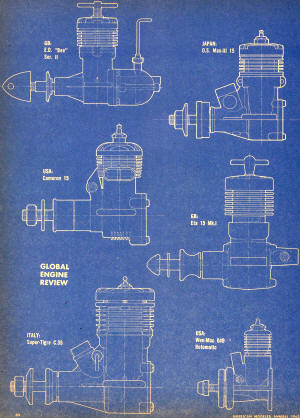 When
a secondhand R/C multi engine changes hands for $150 it must be
good. Prices up to that level (double the original cost) have been
paid for Clarence Lee's handmade .45's, as used by Doug Spreng to
win the 1960 and 1961 Nationals multi event. When Veco Products
secured Clarence's services to design a 45 for them, we were not
surprised to have another potential Nats R/C winner. In fact, it
took the C/L stunt event as well. Clarence also made .49's but adopted
the .45 since it provided a more acceptable balance of power and
fuel consumption for those currently favored multis. Having seen
some of the bigger engines run out of gas at the recent World R/C
Championships, we think he had a good point! When
a secondhand R/C multi engine changes hands for $150 it must be
good. Prices up to that level (double the original cost) have been
paid for Clarence Lee's handmade .45's, as used by Doug Spreng to
win the 1960 and 1961 Nationals multi event. When Veco Products
secured Clarence's services to design a 45 for them, we were not
surprised to have another potential Nats R/C winner. In fact, it
took the C/L stunt event as well. Clarence also made .49's but adopted
the .45 since it provided a more acceptable balance of power and
fuel consumption for those currently favored multis. Having seen
some of the bigger engines run out of gas at the recent World R/C
Championships, we think he had a good point! At the other
end of the Veco range, the .19 and .19 R/C are pleasant handling,
well performing motors. Veco's .29 and .35 sizes include a .29R
for Team Racing and Proto Speed and .35 Combat and R/C engines .
The current Johnson range manufactured by Dynamic Models
is distinguished by the biggest crankshaft journal yet on a model
engine ... 5/8" diameter. This permits exceptionally generous gas
passages which contributes much to their high power output. The
Combat Special .36 is especially popular on this account. Two ball-bearing
versions of the engine include an R/C version. This latter is equipped
with Johnson's special Auto-Mix carburetor fitted with a self compensating
needle-valve to meter fuel in accordance with your throttle opening.
Dynamic also makes Holland Hornet engines designed by former
National Champion, Bob Holland. Hornets, which have racked up an
enviable record in Half-A free-flight over the years, are also offered
in an .051 size for Class A and as a dual needle-valve 2-speeder.
Another Johnson product is the Gilbert engine, made in two sizes
for A. C. Gilbert "American Flyer" ready-to-fly models. These rugged
motors use the seldom seen 3-port (or sideport) layout in which
fresh gas is admitted to the crankcase though a port in the lower
part of the cylinder instead of through a rotary-valve or reed-valve.
One of the biggest manufacturers, Wen-Mac, makes but one
basic type. Wen-Mac turn out as many as 4,500 Half-A size glow engines
per day, most go into their plastic ready-mades. Developed from
a design by Bill Atwood, the Wen-Mac .049 is available in two models,
the Hustler and the Rotomatic, with patented self-engaging recoil
starter.
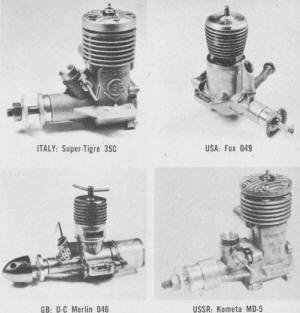 Cameron
Precision Engineering Co., who, before making motors under their
own name, manufactured engines and engine parts for other firms,
are currently offering their .15 c.i.d. engine in standard and throttle
equipped versions. Well made and easy starting, these low priced
motors are excellent values. A very extensive range of Cameron marine
accessories is also available. Cameron
Precision Engineering Co., who, before making motors under their
own name, manufactured engines and engine parts for other firms,
are currently offering their .15 c.i.d. engine in standard and throttle
equipped versions. Well made and easy starting, these low priced
motors are excellent values. A very extensive range of Cameron marine
accessories is also available. Dooling Brothers report that
they still have their famous .29 and .61 facing engines on their
production list. Batches of these are made "as and when" shop schedules
permit. Meanwhile, most spare parts for these engines can be obtained.
A new American entry are the Dew .45 and .51 engines for
R/C work. No details presently available. GREAT
BRITAIN - If America has set the standards by which the
glow engines of the rest of the world are judged, then the British
may be said to have done the same with diesels although they were
not the first to produce a model diesel. Credit for that goes to
the Swiss for the original .12 c.i.d. Dyno engine. But most of the
progress in diesel design has originated in England. The
Oliver-Tiger .15 is certainly the most famous British engine in
contest circles. It has an almost unbeaten record in national and
international FAI class team-racing and until the advent of ultra
high performance glow .15's, was a favorite for FAI free-flight.
Made by the John Oliver father-and-son concern in Dorset, the secret
of Oliver success is in the meticulous hand work that goes into
the finishing and fitting of each engine. Design-wise the Tiger
2.5 c.c. Mk III (.15) and its smaller brother, the Tiger-Cub 1.5
c.c. Mk II (.09) are fairly orthodox and feature shaft valve, radial
porting and twin ball-bearings. At extra cost they are also available
in factory-modified versions giving up to 20 percent more power..
or approximately .36-bhp for the .15 and .23 for the .09.
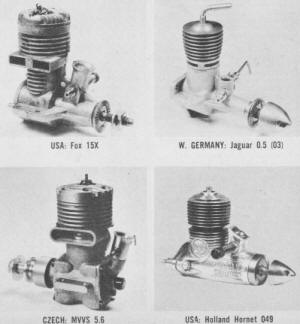 A
rival for the Tiger is the Eta 15 diesel, also with twin ball-bearings
and radial porting, but disc valve intake. The stock version of
this motor will produce about .35 horsepower and speeds of over
100 mph have been reached with good FAI team-racers. The makers,
Eta Instruments Ltd., also build two glow engines, the most successful
of which has been their disc-valve, twin ball-bearing, ringed piston
.29. Speed flyer Major Gus Johnson of the USAF has topped 150 mph
with a model powered by one of these. A
rival for the Tiger is the Eta 15 diesel, also with twin ball-bearings
and radial porting, but disc valve intake. The stock version of
this motor will produce about .35 horsepower and speeds of over
100 mph have been reached with good FAI team-racers. The makers,
Eta Instruments Ltd., also build two glow engines, the most successful
of which has been their disc-valve, twin ball-bearing, ringed piston
.29. Speed flyer Major Gus Johnson of the USAF has topped 150 mph
with a model powered by one of these. A third .15 diesel
which has achieved a place in team-racing is the Rivers Silver-Streak.
This front rotary motor has a unique shaft design with special needle
roller bearings. Rivers make a 3.5 c.c. (.21 c.i.d.) engine of similar
design called the Silver Arrow and this is also available in a slightly
reduced bore version to come within the American .20 c.i.d. Class
A limit. Diesels of over .15 c.i.d. are frequently rather harsh
running, but the Silver Arrow is comparable in both power and smoothness
with a good .19 glow engine. Another .19 contest diesel
with pleasing characteristics is the P.A.W. 19-D, built mainly for
British combat flying (which limits engine displacement to .21 c.i.d.).
This and its companion .15 and .09 models are the work of J.G. ("Gig")
Eifflaender who, before becoming an engine manufacturer, accumulated
many years of know-how by running a model engine re-boring and repairing
service. Oldest diesel still manufactured in Britain is
the Mills. Actually, the present Mills 1.3 (.08) has remained virtually
unaltered for thirteen years and its basic design goes back to the
original Mk I Mills 1.3 which came on the market in the summer of
1946. The smaller .45 c.i.d. "75" model is not quite so old, but
both engines are long-stroke, side-port types; easy to handle and
are still widely recommended for beginners.
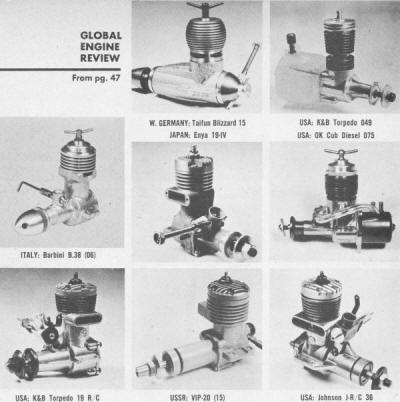 Easy
starting small diesels are also produced by Allbon Saunders (.034
c.i.d. A-S 55) and Marown Engineering (.06 M. E. Heron). Both are
well-made radially ported shaft valve motors with detachable fuel
tanks. M.E. also offers an .09 of similar design. Easy
starting small diesels are also produced by Allbon Saunders (.034
c.i.d. A-S 55) and Marown Engineering (.06 M. E. Heron). Both are
well-made radially ported shaft valve motors with detachable fuel
tanks. M.E. also offers an .09 of similar design. Among
the larger manufacturers, International Model Aircraft Ltd., a division
of the big Lines Brothers toy organization, currently lists eight
diesels and three glow engines under their "Frog" trademark. The
diesels range from .049 to .21 c.i.d. and are of varied types. The
149-D Vibramatic, for example, has a unique type of automatic intake
valve consisting of a steel shim diaphragm backed by a light coil
spring. Having the same bore and stroke are the 150R with normal
shaft valve and the 1500 Viper with rear rotary drum valve and twin
ball-bearings. A plain bearing glowplug version of this latter mill
is called the Venom. There is also an .06 based on the 150R crankcase.
The 249-BB is a .15 twin ball-bearing diesel ... also obtainable
in a modified contest version with improved porting. The 349 is
a loop-scavenged .21 fitted with one ball-bearing and a rear drum
valve; for R/C she's equipped with a barrel throttle and a neat
exhaust extension for easy coupling to a pipe or muffler. Frog's
smallest diesel is the 80 ... a glow version is called the 049-RG.
Largest Frog is the rather elderly (1949) 500-RG, a .30 c.i.d. loop-scavenged
glow job with a ball thrust race. E.F. is another firm with
a "mixed bag" of mills. One of their best, the Super-Fury .09 contest
diesel, has a twin ball-bearing shaft and a non-metallic disc valve
with alternate drive sockets for right or left handed rotation.
Their "Racer" .15, introduced in 1951, has been one of their most
successful and their Hunter .21 made the first R/C model aircraft
crossing of the English Channel. Just announced by E.D. is a beginner's
.06 Cadet. With this George Fletcher, E.D.'s new designer, is after
docility and quietness. The Cadet has side port induction, spring
starter and a neat, effective muffler as standard equipment. Coming
is an entirely new job, the Condor 60 glow for R/C multi with twin
roller bearings.
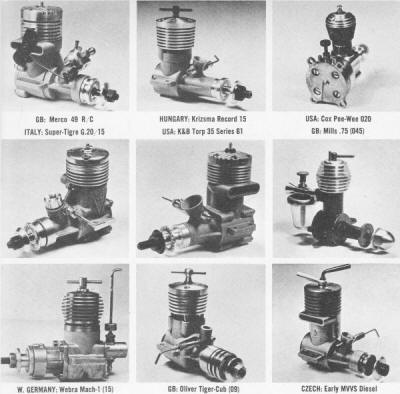 While
production at the Davies-Charlton plant on the Isle of Man is concentrated
mostly on small diesels for fly-for-fun modelers, three years ago
this firm also began manufacture of one of the most ambitious power-plants
ever unveiled by a British firm. This was the Tornado .29, a precision
made, horizontally opposed, twin-cylinder glow with dual rotary
valves fed from a single carburetor. Since a one-piece crankshaft
is used the conrods have detachable caps - per full scale practice
- each secured with two screws. Like most twins, it offers no power
advantage over a good .29 single, but the remarkable smoothness
of the simultaneous-firing opposed cylinder arrangement is a real
delight. Davies-Charlton also make the Bantam, a beginner's .046
glow, which is one of the last expensive motors in the U.K. While
production at the Davies-Charlton plant on the Isle of Man is concentrated
mostly on small diesels for fly-for-fun modelers, three years ago
this firm also began manufacture of one of the most ambitious power-plants
ever unveiled by a British firm. This was the Tornado .29, a precision
made, horizontally opposed, twin-cylinder glow with dual rotary
valves fed from a single carburetor. Since a one-piece crankshaft
is used the conrods have detachable caps - per full scale practice
- each secured with two screws. Like most twins, it offers no power
advantage over a good .29 single, but the remarkable smoothness
of the simultaneous-firing opposed cylinder arrangement is a real
delight. Davies-Charlton also make the Bantam, a beginner's .046
glow, which is one of the last expensive motors in the U.K.
D. J. Allen Engineering Ltd., of Edmonton, London, produce four
orthodox diesels in popular displacements, .06, .09, .15 and .21,
designed by Dennis Allen. Before entering the model engine business,
he had been one of the first British modelers to take up U-control
and, later, R/C flying. More recently, Allen has been turning out
the A-M .049 glow engine - an English version of the Wen-Mac. In
July 1961 Allen also took over the manufacture of Merco engines
from stunt flier Bill Morley and engine tuning wizard Ron Checksfield.
Back in '58 this pair had set out to provide British modelers with
a stunt .35 comparable with top American equivalents. The Merco
.35 is now the most widely flown stunt engine in Britain with a
long string of contest successes in the hands of such experts as
Frank Warburton and Ray Brown. The engine is also offered as a reduced
bore .29 and there are R/C versions of both sizes. These latter
are fitted with barrel type carburetor throttles linked to exhaust
blanking plates.
 Just
before Merco manufacture shifted to Allen Engineering, a new engine
was released, the 49 R/C. Now in production in both standard and
R/C versions it is one of the finest mills ever made in the U.K.
featuring twin ball-bearings, ringed aluminum piston and high grade
construction. One of the most powerful R/C multi engines available,
it offers .70-bhp be-tween 11,000 and 11,500-rpm on 5 percent nitro-methane
fuel and is noted for its above-average power on such larger props
as 12x6 and 12x8. Two of the three engines used by the winning British
team at the 1962 World R/C Championships were Merco 49 R/C's. Just
before Merco manufacture shifted to Allen Engineering, a new engine
was released, the 49 R/C. Now in production in both standard and
R/C versions it is one of the finest mills ever made in the U.K.
featuring twin ball-bearings, ringed aluminum piston and high grade
construction. One of the most powerful R/C multi engines available,
it offers .70-bhp be-tween 11,000 and 11,500-rpm on 5 percent nitro-methane
fuel and is noted for its above-average power on such larger props
as 12x6 and 12x8. Two of the three engines used by the winning British
team at the 1962 World R/C Championships were Merco 49 R/C's.
A favored engine for R/C boats in Britain is the water-cooled
Taplin Twin diesel. An air-cooled airplane version is also offered
and the new Mark 2 has been increased from .42 to .49 displacement
featuring a needle roller nose bearing in addition to three ball-bearings.
The Taplin is a vertical in-line, alternate-firing twin - unusual
in that crankshaft parts are pressed together after being inserted
in the center bearings, the drive then being taken via a separate
extension shaft. This twin is fitted with an effective barrel throttle
carburetor and an exhaust manifold. It has a nickel-plated crankshaft,
hard-chromed cylinders.
 JAPAN
- This country's best-known model engine firms are O.S.
and Enya. O.S. is one of the oldest manufacturers of model motors.
Owner Shigeo Ogawa built his first miniature power-plant in 1936
and went into production in 1937-38 with a .10 c.i.d. motor at the
rate of about 20 per month. By 1941, Ogawa had designed seven more
types, ranging from .27 to .58 c.i.d. After WW-II he re-established
his factory on a larger scale and produced several more types including
a ball-bearing disc-valve racing .64. The big-time turning point
came after 1950 with the original O.S. .29. This engine was distributed
in the U.S. by Bill Atwood and production went up to over 1000 per
month. In 1956, the then new O.S. Max-1 15 helped win the World
F/F Championship for Britain's Ron Draper and the O.S. name soon
became known to modelers throughout the world. JAPAN
- This country's best-known model engine firms are O.S.
and Enya. O.S. is one of the oldest manufacturers of model motors.
Owner Shigeo Ogawa built his first miniature power-plant in 1936
and went into production in 1937-38 with a .10 c.i.d. motor at the
rate of about 20 per month. By 1941, Ogawa had designed seven more
types, ranging from .27 to .58 c.i.d. After WW-II he re-established
his factory on a larger scale and produced several more types including
a ball-bearing disc-valve racing .64. The big-time turning point
came after 1950 with the original O.S. .29. This engine was distributed
in the U.S. by Bill Atwood and production went up to over 1000 per
month. In 1956, the then new O.S. Max-1 15 helped win the World
F/F Championship for Britain's Ron Draper and the O.S. name soon
became known to modelers throughout the world. Latest offerings
are Max-6, Max-19 and Max-49, the latter two also available in R/C
versions. Max-49 features a single inner ball-bearing supplemented
by a bronze outer bush; the R/C job has a coupled throttle system
of intricate design. This consists of a barrel throttle with adjustable
air-bleed idling mixture control, remote needle-valve metering fuel
to a separate jet and a neat exhaust valve enclosed in a diecast
extension. The engine which delivers .65·bhp at 11,200-rpm on 5
percent nitro fuel is not overly heavy at 11 oz.
 Ogawa's
19, first O.S. of this displacement, is a little larger all round
than the popular 15, but otherwise resembles the latest Max-III
15 with three-point (instead of two-point-as on the Max-II 15 and
Max-III 29's and 35's) cylinder fixing and a counterbalanced prop
driver. For R/C the 19 has a slightly simplified version of the
Max-49 R/C throttle. The Max-III 15, more powerful than earlier
O.S. 15's and with pressure feed and the venturi insert removed,
has reached .42-bhp on 50 percent nitro in tests. (The factory lists
.48). Ogawa's
19, first O.S. of this displacement, is a little larger all round
than the popular 15, but otherwise resembles the latest Max-III
15 with three-point (instead of two-point-as on the Max-II 15 and
Max-III 29's and 35's) cylinder fixing and a counterbalanced prop
driver. For R/C the 19 has a slightly simplified version of the
Max-49 R/C throttle. The Max-III 15, more powerful than earlier
O.S. 15's and with pressure feed and the venturi insert removed,
has reached .42-bhp on 50 percent nitro in tests. (The factory lists
.48). All O.S. engines are glows. A .15-D diesel was made
four years ago, but despite impressive specification, was not too
successful. The crankcase casting of this later became the basis
for the .15R special ball-bearing racing glow job. Several dozen
of these made during 1960 and 1961 proved outstanding, particularly
for FAI free-flight. Since the engine has not yet reached regular
production it is not included on our list. O.S. is turning out a
special contest version of their .29 known as the .29X which rates
close to .80-bhp at 16,000-rpm on 30 to 40 percent nitro fuel.
Enya currently lists nine different displacement glow engines
and two diesels, along with "TV" (throttle valve) versions of most
of them. One of the most impressive is the .29-III which, on independent
test, reached nearly .70-bhp at 15 to 16,000-rpm. It is also made
in a special ball-bearing version for which .80-bhp is claimed.
These have been doing particularly well for Class B team racers
in Australia. Also successful in competition, the Enya 15-D diesel
broke new ground when it appeared in Mk I form in 1956 Unlike most
other contest diesel 15's, it used a loop-scavenged cylinder and
the largest diameter shaft of any 15 diesel at that time. It came
close to equaling Oliver performance and probably influenced other
designers since it was followed by two successful European .15 diesels
of similar configuration. In 1960 it was replaced by the present
Mk. 2 which has the largest shaft journal of any ball-bearing 1.5
(.453" dia.) and delivers .34-bhp at 15,500 to 16,000-rpm.
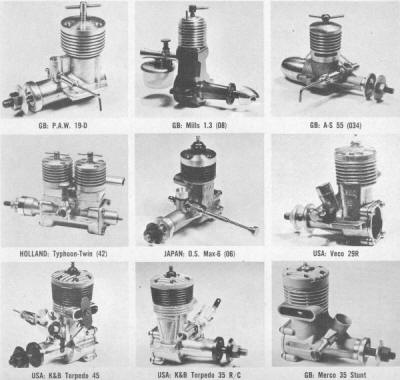 Enya's
biggest is their plain-bearing 50, an extremely rugged motor that
has been in production for the last eight years. This is available
in an R/C edition fitted with a simple throttle-valve. Rather more
complicated throttles are found on R/C versions of the 35-II and
45. These employ a barrel throttle, plus a bypass fuel system with
an extra needle-valve to adjust idling mixture. Enya's
biggest is their plain-bearing 50, an extremely rugged motor that
has been in production for the last eight years. This is available
in an R/C edition fitted with a simple throttle-valve. Rather more
complicated throttles are found on R/C versions of the 35-II and
45. These employ a barrel throttle, plus a bypass fuel system with
an extra needle-valve to adjust idling mixture. Enya engines
are produced by the Enya Metal Products Co. Ltd., of Tokyo under
the direction of three modeling brothers - Jiro, Saburo and Yoshiro
Enya. Fuji low-priced glow engines which fit popular displacements
from .049 to .29 are of orthodox design, the smaller ones being
reverse-flow scavenged, radially-ported types, while the larger
designs are loop scavenged. K.O. engines, built by Kondo
Brothers, are currently confined to radially ported .049, .099 and
.15 diesels plus a loop scavenged glow .15 which is also available
with a coupled throttle system. Finally, from Japan, we
have the Kyowa 45 glow engine. Previously fitted in its R/C version
with a coupled intake-exhaust throttle system similar to that of
the O.S. 35 P/C, the Kyowa recently appeared with a new type carburetor
similar, in principle, to the Johnson Auto Mix.
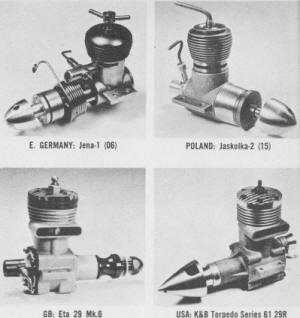 WEST
GERMANY - Here the best known engines are Webra and Taifun.
Webra started in 1951 with a plain bearing .15 diesel followed by
a .09. In 1953 came the powerful, compact, relatively light, twin
ball-bearing, short-stroke disc-valve Webra Mach-1 designed by Gunther
Bodemann. This engine inspired many other continental designs; its
bypass system, consisting of multiple internal cylinder flutes with
the piston riding on thin lands at the bottom of its stroke, has
been seen in the Polish Jasholka, East German Jena and Schlosser
and Hungarian Krizsma-Record. Webra also made a glow version of
the Mach-1 but this never duplicated the popularity of its diesel. WEST
GERMANY - Here the best known engines are Webra and Taifun.
Webra started in 1951 with a plain bearing .15 diesel followed by
a .09. In 1953 came the powerful, compact, relatively light, twin
ball-bearing, short-stroke disc-valve Webra Mach-1 designed by Gunther
Bodemann. This engine inspired many other continental designs; its
bypass system, consisting of multiple internal cylinder flutes with
the piston riding on thin lands at the bottom of its stroke, has
been seen in the Polish Jasholka, East German Jena and Schlosser
and Hungarian Krizsma-Record. Webra also made a glow version of
the Mach-1 but this never duplicated the popularity of its diesel.
Bully-II .21 (not to be confused with earlier Bully shaft
valve and plain bearing engines) also with twin ball-bearings and
disc intake is offered in both R/C and glow versions. Biggest Webra
is the flat twin Boxer .47 c.i.d. diesel, developed from the original
Ruppert twin diesel which aroused so much interest in Europe in
the planes of former R/C multi champion Karl-Heinz Stegmaier famed
for his pneumatic servo system. The Boxer is still available with
a rear mounted vacuum pump for those who use such servo systems.
Webra's smallest are the Piccolo 047 glow and diesel mills.
Sport-Glo was designed at the request of the famous Schuco firm
for their entry into the model plane market. Big-Ben 5 is a .29
glow for R/C.
Taifun
engines-made for and distributed by the Johannes Graupner organization,
Germany's biggest model firm - include six diesels and one glow.
Four of the diesels are .15's, all use radially-ported cylinders
and a 15 x 14mm bore and stroke, but each has a different crankcase
and is quite dissimilar, as the specification table indicates. The
Zvklon has an integral barrel-throttle type carburetor. Also for
R/C is the .21 Bison glow, a loop-scavenged plain bearing shaft
valve motor with coupled swiveling plate type exhaust baffle.
Popular sport type motors on the German market include the
Jaguar and Rebell diesels. These are moderately priced conventional
designs, all with radial porting, shaft valves and plain bearings.
Derived from the Jaguar 2.5 is the Robbe Duo-29, a flat-twin using
Jaguar cylinder assemblies. Flat twins made by Herman Fricke (F.M.O.)
include a .39 c.i.d. diesel and a .61 c.i.d. glow, both with ball-bearing
shafts.
 EAST
GERMANY - The Ferdinand Krick Bambino diesel is basically
the same as the Tomboy engine that was formerly produced by Klaus
Krick in West Germany. For an explanation we have to go back to
1958 when Benno Schlosser, who, with his father Max, turned out
the Schlosser .15 diesel (used that year by Hungary's Erno Frigyes
to win the World F/F Championship), left East Germany for the West.
With him went Ferdinand Krick's son Klaus. The first engine this
group began producing was the Schlosser Tomboy. Later, Schlosser
took a job with Volkswagen and Krick continued to make the Tomboy
for a time under his own name. It is obvious from data and photographs
of the East German Krick Bambino that to all intents and purposes
this is the same engine. EAST
GERMANY - The Ferdinand Krick Bambino diesel is basically
the same as the Tomboy engine that was formerly produced by Klaus
Krick in West Germany. For an explanation we have to go back to
1958 when Benno Schlosser, who, with his father Max, turned out
the Schlosser .15 diesel (used that year by Hungary's Erno Frigyes
to win the World F/F Championship), left East Germany for the West.
With him went Ferdinand Krick's son Klaus. The first engine this
group began producing was the Schlosser Tomboy. Later, Schlosser
took a job with Volkswagen and Krick continued to make the Tomboy
for a time under his own name. It is obvious from data and photographs
of the East German Krick Bambino that to all intents and purposes
this is the same engine. Another East German engine of similar
specs is the WMD-05. In the 1.5 c.c. group (.09 c.i.d.) there is
the Wilo 150, designed by Willi Otto who has made many engines in
the past. Major producer in East Germany is Jenoptik Jena GmbH,
better known as the Carl Zeiss Optical Works at Jena. Jena turns
out a well-made .06 c.i.d. diesel fitted with ball-bearing shaft
and a spring starter, unorthodox in that it is a side port motor
but with the intake projecting horizontally forward, instead of
backward, from the cylinder. Jena also makes six larger diesels
based on a common crankcase and ball bearing shaft assembly. Two
are .12 c.i.d., the others .15's. Their reed-valve .15 models are
reported to produce .36 bhp. ITALY - Like
Fiat in the Italian auto world, Super-Tigre is the leading name
in Italian model engines. Super-Tigres in many types are made by
Micromeccanica Saturno of Bologna under the direction of owner Jaures
Garofali. Their .15 c.i.d. glow for several years have been more
widely used by FAI speed enthusiasts than any other. The present
G.20/15 model is especially interesting for its unique, loop-scavenger
cylinder porting in which the bypass ports open simultaneously with
the exhaust, despite a perfectly flat piston head. Based on the
same main casting as the .15 are .19 and .23 glows and a .15 diesel.
An older Super-Tigre G.30 .15 diesel of entirely different design
has a rear rotary drum valve and circumferential porting.
 Three
basic models are fashioned around S-T's latest series G.21 case.
G.21/29 is a racing engine for which .95-bhp is claimed on nitro.
G.21/35 is basically a combat motor. G.21/40 is also made with a
ringed piston for R/C work with special Super-Tigre throttle assemblies.
Two less expensive plain bearing .35's are offered - one for stunt
with a conventional baffle piston, another for combat with a special
piston and squish-band type head. Three
basic models are fashioned around S-T's latest series G.21 case.
G.21/29 is a racing engine for which .95-bhp is claimed on nitro.
G.21/35 is basically a combat motor. G.21/40 is also made with a
ringed piston for R/C work with special Super-Tigre throttle assemblies.
Two less expensive plain bearing .35's are offered - one for stunt
with a conventional baffle piston, another for combat with a special
piston and squish-band type head. Garofali's S-T .51 and
.56 are bronze bearing ringed-piston motors which have proved popular
for R/C multi. New pistons and deeply finned heads have
overcome the heating troubles experienced with some early examples.
Throttle assemblies are made to fit nearly all the S-T glow range
(also the G.20/15 diesel) although the types recommended as most
suitable for conversion are the .19, .23, .40, .51 and .56.
The Rossi brothers, U go and Cesare, of Brescia, who specialize
in hopping-up Super-Tigres for speed work, are offering a .60 of
their own design. Somewhat similar to the McCoy .60, it is a disc-valve,
ball-bearing affair touted to deliver 1.84-bhp at 18,000-rpm.
U.S.S.R. - As we have remarked, it
is most difficult to get an accurate and up-to-date statement of
engine production in Russia, but our list includes six recent types,
three diesels and three glows, four of which have actually passed
through our hands. All these use pressure-cast parts, which suggests
that they have been made in reasonable numbers .
 The
Kometa .29 and Moscow and VIP-20 .15's were all featured in "Iron
Curtain Engines," American Modeler for August 1962, so no need for
descriptions to be repeated here. The MK-12V, not to be confused
with the earlier MK-12S and MK-12K engines, is a copy of the West
German Webra Mach-1. The MK-16K is an interesting disc-valve .09
with a long crankshaft supported in ball-bearings fore and aft and
having a performance which is comparable with many of the better
European contest diesels of similar displacement. The Kharkov, a
shaft-valve .15 intended for racing and free-flight, apparently
based on the Czechoslovakian MVVS .15 diesel which it closely resembles. The
Kometa .29 and Moscow and VIP-20 .15's were all featured in "Iron
Curtain Engines," American Modeler for August 1962, so no need for
descriptions to be repeated here. The MK-12V, not to be confused
with the earlier MK-12S and MK-12K engines, is a copy of the West
German Webra Mach-1. The MK-16K is an interesting disc-valve .09
with a long crankshaft supported in ball-bearings fore and aft and
having a performance which is comparable with many of the better
European contest diesels of similar displacement. The Kharkov, a
shaft-valve .15 intended for racing and free-flight, apparently
based on the Czechoslovakian MVVS .15 diesel which it closely resembles.
FRANCE - Like Italy, France only two
or three active manufacturers. Best known is Moteurs Micron of Paris.
Micron, one of the pioneer manufacturers of diesels, has produced
numerous types since the war, ranging from baby diesels to a racing
.60. Most are now out of production or made to special order. Their
current list includes four .09 and .15 diesels. .29 and .35 glow
engines. Latest products are the .15 for FAI team-racing and the
.35 for which a throttle carburetor is optional. The Modelsport
MS-10 is a new one built in both diesel and glow types. In contrast,
the Stab 1.25 has been made for 16 years. CZECHOSLOVAKIA
and HUNGARY - Although Some Czech and Hungarian engines
have been made by small independent producers, practically all current
production is now in the hands of the official Model Development
Centers known as MVVS and MOKI. In addition to the four motors listed,
MVVS has a couple of new ones, but these have not yet reached the
stage where they can be considered as "production" offerings.
MOKI now has a diesel version of the front rotary S-2 glow
.15, called the D-1, which they claim delivers .37-bhp at 17,000-rpm.
They have reverted to disc valve for their latest racing glow .15,
the S-3. With this speeds approaching 130-mph on monoline and straight
FAI fuel have been reported. Latest MOKI team-race TR-6 engine has
the same general layout as the TR-4 and TR-5 series, but features
a new crankcase and is generally similar in design to the Oliver
Tiger.
 POLAND
and RUMANIA - Poland's leading designer is Stanislav Gorski,
an accomplished modeler and engineer who built the first successful
Wankel rotary-piston type miniature in Europe. Poland's most widely
used powerplants, the Jaskolka .15 and Sokol .29 diesels, were both
by Gorski. The Jaskolka has progressed through four models - shaft-valve
and reed-valve plain bearing, reed-valve and disc-valve ball-bearing
types. The last two, known as Jaskolka-2 and Jaskolka-3, are included
on our list. Similar variations of the larger Sokol have also been
produced, but a successor to these, the Super-Sokol, also by Gorski,
is being turned out. POLAND
and RUMANIA - Poland's leading designer is Stanislav Gorski,
an accomplished modeler and engineer who built the first successful
Wankel rotary-piston type miniature in Europe. Poland's most widely
used powerplants, the Jaskolka .15 and Sokol .29 diesels, were both
by Gorski. The Jaskolka has progressed through four models - shaft-valve
and reed-valve plain bearing, reed-valve and disc-valve ball-bearing
types. The last two, known as Jaskolka-2 and Jaskolka-3, are included
on our list. Similar variations of the larger Sokol have also been
produced, but a successor to these, the Super-Sokol, also by Gorski,
is being turned out. This engine is an entirely new design.
The standard production version is a diesel manufactured by Ryszard
Szmidtke of Mielec. Unlike the older Sokols, it is loop-scavenged
(the first Polish engine of this type) with ball-bearing shaft and
disc intake. Unique among diesels, it has a curved baffle on the
piston, the contra-piston being recessed to take this. A glow version
is assembled by the Polish Model Test Center in Warsaw. Rated .50-bhp
at 14,000-rpm it is for C/L stunt work. In addition, the Test Center
is making a limited number of throttle equipped versions for R/C
and scale U-control models. The conversion consists of a simple
butterfly valve in the intake which linked to a pivoted blade type
exhaust restrictor drops rpm to 3 or 4,000 according to prop used.
Rumania is the latest East European country to produce its
own engine, the I.O.R. 2.5. Based on the Webra Mach-1 it is built
by Ruma-nian Optical Industries. HOLLAND and
NORWAY - Three Dutch Typhoon motors in our list are by
Miniatuur-Motorenfabriek Ty-phoon of Amsterdam. The last type produced
by the company was the .42 c.i.d. Typhoon-Twin, an in-line, alternate-firing,
throttle-equipped diesel like the British Taplin, but with a special
type of rotary-valve contained in the center coupling section of
the 3-piece crankshaft. The engine has an extra power take-off shaft
at the rear, suitable for driving a vacuum pump for pneumatic servo
operation. Typhoon's .29 disk-valve ball-bearing diesel
was developed from the company's earlier racing .29; the R. 250
is an orthodox annular ported ball-bearing diesel.
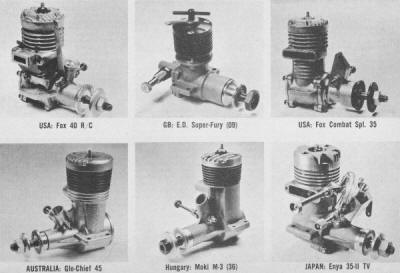 Norway's
Jan David-Andersen, one of the earliest manufacturers of diesels,
put his first engine into small scale production late in 1944. A
keen boat and airplane modeler, David-Andersen continued experimenting
with various types of diesels before settling down to regular production
in 1950 with a sturdy multi-purpose .15, which was later joined
by an .06. Both have been superseded by improved models and current
D-A production is concentrated on the three motors listed. These
are superbly made with many pleasing refinements, such as glandnuts
on the compression-screw and needle-valve to adjust tension. A full
range of accessories, including throttles, exhaust extensions, water-jackets
and marine drive assemblies, is also produced by David-Andersen
Motors. Norway's
Jan David-Andersen, one of the earliest manufacturers of diesels,
put his first engine into small scale production late in 1944. A
keen boat and airplane modeler, David-Andersen continued experimenting
with various types of diesels before settling down to regular production
in 1950 with a sturdy multi-purpose .15, which was later joined
by an .06. Both have been superseded by improved models and current
D-A production is concentrated on the three motors listed. These
are superbly made with many pleasing refinements, such as glandnuts
on the compression-screw and needle-valve to adjust tension. A full
range of accessories, including throttles, exhaust extensions, water-jackets
and marine drive assemblies, is also produced by David-Andersen
Motors. AUSTRALIA Current Aussie
production is confined to the engines made by Gordon Burford &
Co., Ltd. Eight models include the Glo-Chief .19, .29, .35 and .45
glow jobs, the Taipan .09, .15 and .15 ball-bearing diesels, and
the Taipan .15 glow. The glows are conventional loop-scavenged motors;
the diesels are reverse-flow scavenged (i.e., radial port) motors.
All are shaft-valve engines, soundly engineered and of good performance.
Their well-produced crankcases are diecast. R/C versions of the
19 and 45 have recently been shown. Additions to this listing
will appear in future issues of American Modeler.
Articles About Engines and Motors for Model Airplanes, Boats, and Cars:
|